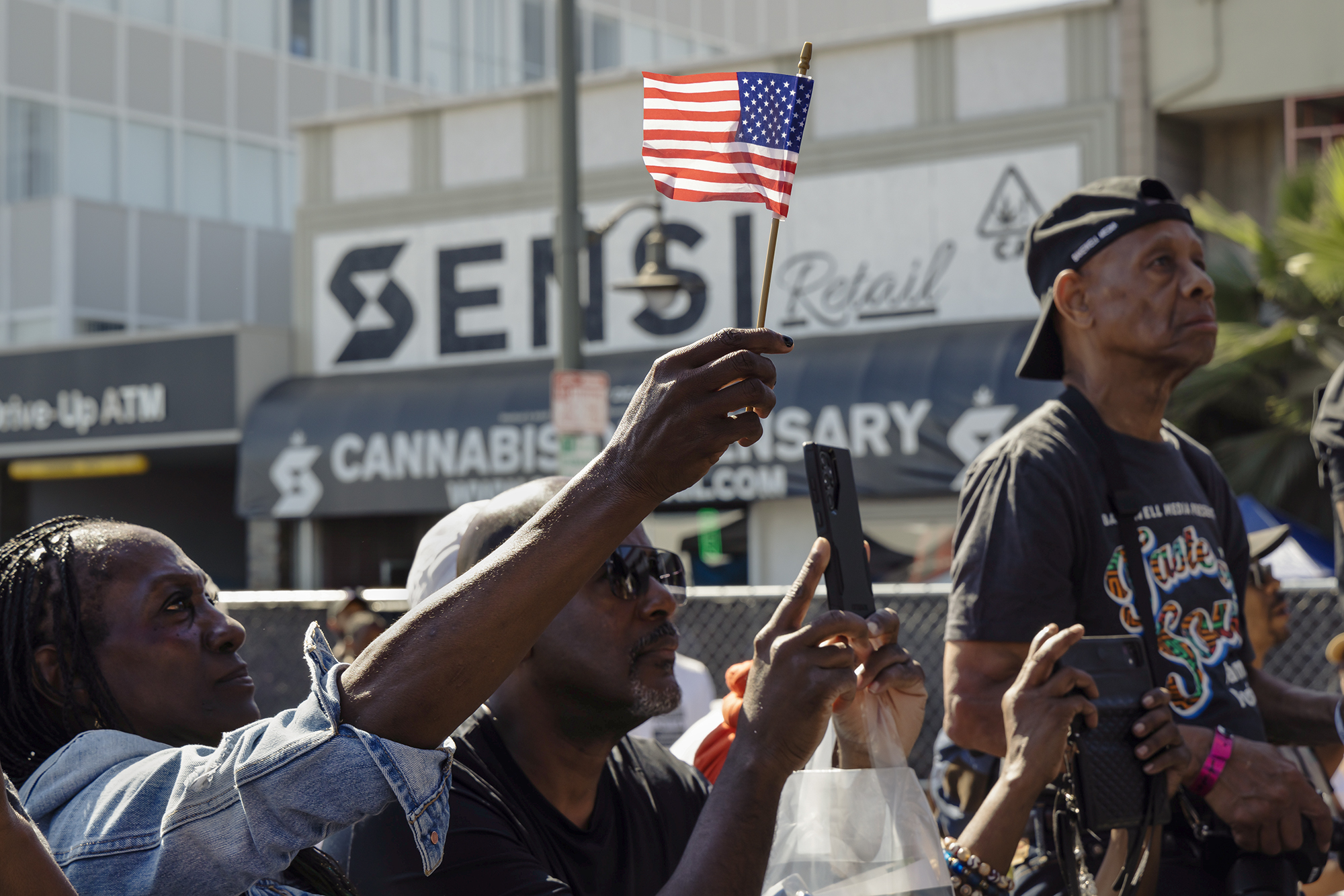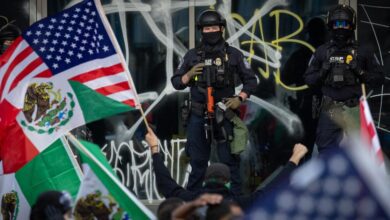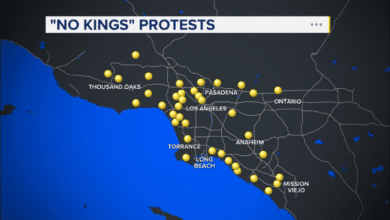In this California election, one race spotlights Latino-Black politics

In summary
An Assembly election in South L.A. captures the shifting dynamics of ethnic political power in California. One candidate is biracial and pledges to build bridges between Black and Latino voters.
Lea esta historia en Español
LOS ANGELES — The two dozen volunteers gathered on a Saturday morning at the appropriately — almost cinematically — named Unity House got the message over and over and over again as they reviewed what to tell voters about Sade Elhawary.
Her bid for the 57th Assembly District, a historically Black swath of South Los Angeles that is now predominantly Latino, aims to build Black and brown solidarity and the political power of both groups. Elhawary, a 36-year-old former teacher and community organizer seeking public office for the first time, is herself biracial, the daughter of Guatemalan and Egyptian immigrants.
“If people learn that stuff,” the deputy campaign manager said as she flipped through a Powerpoint presentation, “they’ll vote for us every time.”
Elhawary is running against Efren Martinez, a 44-year-old business consultant and fellow Democrat, at a dynamic and sensitive moment for South L.A., whose complex ethnic politics were central to a leaked racist recording about redrawing council districts that shook the city two years ago.
The neighborhood that elected the first African-Americans to the California Legislature a century ago is now, after decades of immigration, finally poised to send a Latino member to Sacramento — a triumph for the local Latino community, which has long lagged in political representation, but one that could come at the expense of a platform for the state’s shrinking Black population.
Race is not the main campaign issue in a district where housing affordability and homelessness, unemployment and crime are everyday concerns. It’s also unavoidable. Both candidates are making explicit overtures to the diverse electorate — Martinez visits Black churches on Sunday mornings, Elhawary hands out posters declaring that she is “uniting our Black & brown community” — that they can be trusted to represent everyone and won’t leave Black or Latino residents behind.
“The world expects you to choose,” Elhawary said in an interview in her upstairs office at the Unity House, surrounded by memorabilia from her youth. A certificate from her Assembly member recognized teenage Elhawary for helping organize a college and career conference for Latina high schoolers in 2007.
“There are definitely times and places where people say, ‘Well, if you’re part of this, that means that you only care about Black people. And if you’re a part of this, that means clearly you don’t want to be a part of us.’ And I think that that’s totally not true. That’s not who I am,” she said.
“If anything, it means that I get to bring a Latino perspective into Black spaces, too, and remind folks that if we want to do this work, we have to be in solidarity because you don’t build power in silos.”
The birth of ‘Black-brown politics’
Building solidarity between Black and Latino residents has been a project in South Los Angeles for more than three decades.
The neighborhood originally became a core of African-American culture and political activity in California during the first half of the 20th century, when racially restrictive housing laws forced Black migrants arriving in Los Angeles from the South to settle there. But after middle-class families began moving away in the 1970s and 1980s because of a shrinking industrial sector and rising crime, they were replaced by waves of immigrants escaping economic crises and wars in Central America.
This transition led to explosive tension over jobs and resources — and the establishment of civic organizations to ease the conflict, such as Community Coalition, a racial and economic justice advocacy group founded in 1990 by now-Los Angeles Mayor Karen Bass.
“There’s a lot of attention to Black-brown politics,” said Manuel Pastor, a professor of sociology and American studies and ethnicity at the University of Southern California, who wrote a book about the demographic shift in South L.A. “It’s present, but it’s not always spoken.”
Even as the population of the area has radically changed over the past 50 years — from 80% Black to more than two-thirds Latino now — representation has not. State and local officials are still mostly African-American.
Black political power remains outsized in South L.A. because many of the Latino residents are immigrants who are not U.S. citizens and cannot vote, while Black homeowners who have remained are deeply civically engaged. The 57th District is about 71% Latino and 17% Black, according to estimates from the 2020 Census, but that gap shrinks to 48%-29% among voting-age citizens.

Younger generations of Latinos also grew up surrounded by Black culture, Pastor said, and are comfortable with African-American leaders. Local politicians adapted by fostering ties to the Latino community, including by providing immigration services.
“It’s not as monochromatically simple,” said Pastor, who has donated to Elhawary’s campaign. Rather than the traditional political model of ethnic succession, he said, “what seems to be going on in South L.A. is ethnic sedimentation — building on what’s there.”
Yet it’s not all harmonious. There are Latinos restless for more political power and a real fear that the Black community is being erased as displacement and gentrification continue to transform South Los Angeles.
Those were undercurrents of a 2022 scandal in which three Latino Los Angeles city councilmembers were caught making racist comments about Black people and disparaging remarks about their colleagues. In a recording that leaked online, they expressed frustration about the once-a-decade redistricting process and discussed keeping economic assets in heavily Latino districts, including USC and Exposition Park, which two Black councilmembers in South L.A. had been fighting over.
It was a painful moment for the community, said Raphael Sonenshein, the director of the John Randolph Haynes and Dora Haynes Foundation, who has written books about the racial politics of Los Angeles. But it also underscored, by contrast, how deliberate political leaders in South L.A. have been about maintaining their multiracial alliance.
“It’s not a surprise. There’s been plenty of time to think about it,” Sonenshein said. But, he added, “Nothing is smooth when you have different groups at play that have different interests.”
‘Every district is a Black district’
Though representation may not be at the forefront of voters’ mind in the 57th Assembly District, the political class is certainly thinking about it.
In Sacramento, ethnic caucuses are engaged in an enduring — and still unfinished — push to diversify the Legislature to fully reflect California’s population. It’s a simple idea that has proved difficult to achieve; change can come slowly when incumbents are able to spend more than a decade in office before terming out and gains for one minority group may be at the expense of another.
Latinos, now the largest ethnic group in California with about 40% of the population, still comprise fewer than a third of the 120 seats in the Legislature. State Sen. Lena Gonzalez, a Long Beach Democrat who leads the California Legislative Latino Caucus, declined an interview request, but said in a statement that the caucus is “dedicated to promoting diverse representation in the Legislature. This includes striving to ensure that the proportion of Latinos in the Legislature mirrors their proportion within the state’s population, as well as achieving gender parity, parity for other minority groups, age demographics, and diverse backgrounds.”
Meanwhile, there are no majority — or even plurality — Black legislative districts left in the state, where the Black share of the population has fallen to less than 6%. A handful of districts where Black voters still make up a quarter or more of the electorate do remain in Los Angeles and Oakland.
The California Legislative Black Caucus, which now has 12 members, has consequently had to rethink its campaign strategy, including by recruiting and developing candidates in areas that might not typically elect Black representatives.

“We are saying every district is a Black district, every district needs representation, every district has Black voices,” said Assemblymember Lori Wilson, a Suisun City Democrat who leads the caucus. It has endorsed Elhawary.
Though the caucus is trying to “do a better job of educating our colleagues on what the issues are and how to be a good ally to us,” Wilson said it was important to maintain enough Black representation in Sacramento so that they have “a critical mass there to enact change.” But she doesn’t want it to come at the expense of Latino members; she said it was “beautiful” that Elhawary could bridge both groups with her mixed heritage.
“We cannot be divided,” Wilson said. “This is not the oppression Olympics. We’ve both been oppressed.”
The district’s Assemblymember Reggie Jones-Sawyer, who is Black, represented South L.A. for 12 years and terms out in December. He said he occasionally heard talk about needing to put a Latino representative in his seat, but that it wasn’t aggressively pursued because he had a strong track record of supporting Latino issues — such as bills providing overtime pay for farmworkers and resources for undocumented immigrants — that was even better than some Latino legislators.
“My vote was very important to the Latino Caucus,” he said. “I think that saved me over the 10-plus years of trying to get reelected.”
He did face a fight for his political survival in 2020, when Martinez upset him in the top-two primary. Jones-Sawyer said he organized a focus group with the district’s Latino voters, who were more concerned about being able to access public services and get food on the table amid the coronavirus pandemic than the post-George Floyd civil rights protests dominating the political discourse at the time.
“It was like a lightning bolt,” he said. “Everything we thought was the appropriate way to act was wrong.”
Jones-Sawyer said he refocused his campaign on food distributions and other direct services, which helped him fend off Martinez in their nasty runoff campaign.
“That’s what won people over. Not the racial politics,” he said. “I hope we don’t start a war. Because if Latinos and African-Americans are fighting each other over resources in an area that’s impoverished, we both lose.”
Does a multiracial message still resonate with voters?
It was the racist tape scandal — which suggested precisely such a battle coming to a head in city politics — that sparked Elhawary’s Assembly bid.
A longtime youth organizer with Community Coalition who was working on Bass’ mayoral campaign at the time, Elhawary said she felt compelled to speak out both “as a Black person who knows that this is wrong” and “as someone who understands that Latinos also need to kind of bring our community together.” Her experience commenting at a city council meeting on behalf of the Black Los Angeles Young Democrats emboldened her to lead in a different way and a few months later, she decided to run for office.
Her campaign has so heavily emphasized her biracial identity in part because Elhawary said it was important to help voters understand her focus on solidarity and social justice. She believes she could play a unique role in the Legislature, providing a Latino voice to help build support around Black issues, such as reparations, and vice versa.

“Folks see every day the way that we have been underinvested, underserved and just the ways that this particular community has had less resources,” she said. “And I think because of that, it means that folks know that we’re in this together.”
But her background is also something that Elhawary said she’s always had to justify — including to the voters whose support she is now seeking.
In the March primary, Martinez put out an ad calling Elhawary “shady” for going by her middle name, Sade, instead of her first name, Zeinab; allies publicly criticized that message for trying to “Blacken” Elhawary to scare off Latino voters. Another candidate, the reparations advocate Tara Perry, campaigned as the “only African American woman” in the race, implying that Elhawary was not Black because she was not a descendent of slaves.
“Especially if you can’t be plugged in, you vote based on what’s familiar to you,” Elhawary said. “For someone like my uncle, who grew up not too far from here, he’s like, ‘Well, I go down based on names. Like whoever sounds like they’re Latino, I’m voting for them because that’s what feels good.’”
It’s unclear exactly what exactly will sway voters in what is likely to be a close race. In the top-two primary, Martinez, whose campaign has emphasized public safety, received nearly 33% of the vote, and Elhawary, running as an unabashed progressed, won about 31%, while three other candidates split the rest.
Martinez did not respond to repeated interview requests from CalMatters.
“We cannot be divided. This is not the oppression Olympics. We’ve both been oppressed.”
ASSEMBLYMEMBER LORI WILSON, CHAIRPERSON OF THE California Legislative Black Caucus
In conversations with voters, housing comes up as the top issue. But the campaign has also been flooded in recent weeks with millions of dollars in outside spending — from labor unions, trial lawyers and Uber for Elhawary, from oil companies, law enforcement groups and the dialysis clinic operator DaVita for Martinez. A significant portion is funding attack ads that hit Elhawary for not growing up in the district and Martinez for his connection to an abusive campaign worker.
Eating lunch with her congregation after services at St. Patrick’s Catholic Church on a recent Sunday, Isela Aguirre said she ultimately decided to vote for Martinez because he seemed trustworthy and genuine. The 51-year-old South L.A. native, a regional property supervisor for homeless and low-income supportive housing, said Elhawary’s slogans about unifying the Black and brown communities seemed too canned.
“The community wants to look out for a leader who’s looking out for them. But just because someone is the same ethnicity doesn’t mean they’re looking out for them,” Aguirre said. “We need to see someone who can work with everybody.”
Aguirre said a shared racial identity was important for older generations of minority groups that needed to stick together for their survival, but it causes division when emphasized too much. As a voter, she looks instead at what organizations and officials a candidate is associated with.
“While it gets you in the door, your ethnicity, if you don’t do something that helps that community, don’t expect longevity,” she said.
‘We don’t just want a Black face in a high place’
After dispatching her volunteers to knock on doors, Elhawary attended the Taste of Soul, an annual street festival along South L.A.’s historic Crenshaw Boulevard that is a massive gathering for Black Angelenos.
Between music performances on the main stage, the emcee introduced a parade of politicians, including Rep. Adam Schiff, the Democrat who is likely to be California’s next U.S. senator, several gubernatorial hopefuls and a video message from Vice President Kamala Harris. During remarks urging attendees to get out the vote, Bass, who has appeared in campaign material endorsing Elhawary, called her out as “a young woman that represents the future.”
Then Elhawary waded into the crowd to make her pitch to voters, taking selfies with people who recognized her from digital ads that have been running nonstop.
“She’s for the people, and that alone tells me should be a good representative,” said Ronald Taylor, a 62-year-old Caltrans worker, who was pleased by her “rainbow coalition” message. “She’s going to be an ambassador to us.”

A small group of older Black men wandered by carrying a poster with the faces of the California Legislative Black Caucus crossed out. Frustrated by the failure of major reparations bills in the Legislature this summer, they are among a group of activists now campaigning for the opponents of Black Caucus members, including Republicans. They asked Elhawaray if she would support reparations.
“Absolutely,” she told them, responding so quickly it was almost instinctive. “We’ve got to be in lockstep.”
Trailing steps behind them was Kamilah Moore, chairperson of the California Reparations Task Force. Elhawary pulled her into a photo, but after she walked away, Moore confessed that she hadn’t really wanted to pose together.
Moore, who does not live in the 57th Assembly District, said she recently attended a taco meet-and-greet with Martinez and was considering whether he might provide “real representation” for the cause of reparations.
“We want Black representation,” Moore said, “but we don’t just want a Black face in a high place.”




